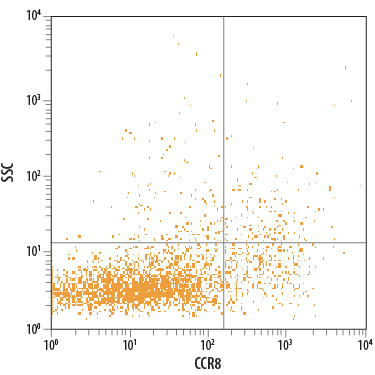Human/Rat CCR8 PE-conjugated Antibody
Human/Rat CCR8 PE-conjugated Antibody Summary
Met1-Leu355
Accession # P51685
Applications
Please Note: Optimal dilutions should be determined by each laboratory for each application. General Protocols are available in the Technical Information section on our website.
Scientific Data
 View Larger
View Larger
Detection of CCR8 in Human PBMCs by Flow Cytometry. Human peripheral blood mononuclear cells (PBMCs) were stained with Mouse Anti-Human Integrin aM/CD11b Alexa Fluor® 488-conjugated Monoclonal Antibody (Catalog # FAB16991G) and either (A) Rat Anti-Human/Rat CCR8 PE-conjugated Monoclonal Antibody (Catalog # FAB1429P) or (B) Rat IgG2BPhycoerythrin Isotype Control (Catalog # IC013P). View our protocol for Staining Membrane-associated Proteins.
 View Larger
View Larger
Detection of CCR8 in Rat Splenocytes by Flow Cytometry. Rat splenocytes were stained with Rat Anti-Human/Rat CCR8 PE-conjugated Monoclonal Antibody (Catalog # FAB1429P). Quadrant markers were set based on control antibody staining (Catalog # IC013P). View our protocol for Staining Membrane-associated Proteins.
Reconstitution Calculator
Preparation and Storage
- 12 months from date of receipt, 2 to 8 °C as supplied.
Background: CCR8
CCR8 (C-C Chemokine Receptor 8), previously called CKR-L1 or TER1 and designated CD198, is a 41-43 kDa member of the GPCR 1 family of transmembrane proteins. CCR8 is expressed on vascular smooth muscle cells, monocytes, eosinophils, peritoneal macrophages, thymocytes, CD8+ T cells, Langerhans cells and neurons. CCL1/TCA3 and vMIP-1 are known agonists for CCR8. Human CCR8 is a 7-transmembrane protein that is 355 amino acids (aa) in length. It contains a 35 aa N-terminal extracellular domain plus a 51 aa C-terminal cytoplasmic tail. Over aa sequences 1-33 and 92-105 collectively, human and mouse CCR8 share 64% aa sequence identity.
Product Datasheets
Citations for Human/Rat CCR8 PE-conjugated Antibody
R&D Systems personnel manually curate a database that contains references using R&D Systems products. The data collected includes not only links to publications in PubMed, but also provides information about sample types, species, and experimental conditions.
5
Citations: Showing 1 - 5
Filter your results:
Filter by:
-
Glatiramer Acetate, Dimethyl Fumarate, and Monomethyl Fumarate Upregulate the Expression of CCR10 on the Surface of Natural Killer Cells and Enhance Their Chemotaxis and Cytotoxicity
Authors: Zaidoon Al-Jaderi
Front Immunol, 2016-10-19;7(0):437.
Species: Human
Sample Types: Whole Cells
Applications: Flow Cytometry -
Distinct roles for CCR4 and CXCR3 in the recruitment and positioning of regulatory T cells in the inflamed human liver.
Authors: Oo YH, Weston CJ, Lalor PF, Curbishley SM, Withers DR, Reynolds GM, Shetty S, Harki J, Shaw JC, Eksteen B, Hubscher SG, Walker LS, Adams DH
J. Immunol., 2010-02-17;184(6):2886-98.
Species: Human
Sample Types: Whole Cells
Applications: Flow Cytometry -
CD56highCD16-CD62L- NK cells accumulate in allergic contact dermatitis and contribute to the expression of allergic responses.
Authors: Carbone T, Nasorri F, Pennino D
J. Immunol., 2009-12-11;184(2):1102-10.
Species: Human
Sample Types: Whole Cells
Applications: Flow Cytometry -
Chemokine-mediated migration of skin-derived stem cells: predominant role for CCL5/RANTES.
Authors: Kroeze KL, Jurgens WJ, Doulabi BZ, van Milligen FJ, Scheper RJ, Gibbs S
J. Invest. Dermatol., 2009-01-01;129(6):1569-81.
Species: Human
Sample Types: Whole Cells
Applications: Flow Cytometry -
Down-modulation of CXCR3 surface expression and function in CD8+ T cells from cutaneous T cell lymphoma patients.
Authors: Winter D, Moser J, Kriehuber E, Wiesner C, Knobler R, Trautinger F, Bombosi P, Stingl G, Petzelbauer P, Rot A, Maurer D
J. Immunol., 2007-09-15;179(6):4272-82.
Species: Human
Sample Types: Whole Cells
Applications: Flow Cytometry
FAQs
-
Are there special considerations for Flow Cytometry using Human CCR8 Antibody, Catalog # MAB1429 and FAB1429?
The staining with this antibody is temperature dependent; it will stain at 4 C and room temperature, however, staining is stronger at 37 C.
Reviews for Human/Rat CCR8 PE-conjugated Antibody
There are currently no reviews for this product. Be the first to review Human/Rat CCR8 PE-conjugated Antibody and earn rewards!
Have you used Human/Rat CCR8 PE-conjugated Antibody?
Submit a review and receive an Amazon gift card.
$25/€18/£15/$25CAN/¥75 Yuan/¥2500 Yen for a review with an image
$10/€7/£6/$10 CAD/¥70 Yuan/¥1110 Yen for a review without an image


